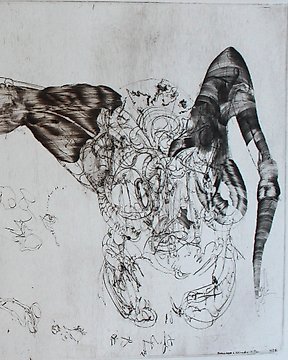
Jiři Anderle (1936) - "Manipulace II" 1976
Nº 82269769

Nº 82269769

Nicholas Mukomberanwa (1940 - 2002) "Together"
Nicholas Mukomberanwa was a famous Zimbabwean sculptor. He was among the most famous products of the Workshop School at the National Gallery of Zimbabwe and an art mentor and teacher to the Mukomberanwa Family of sculptors. His work has been exhibited in galleries around the world and he remains one of Zimbabwe's most famous artists.
Mukomberanwa was heavily influenced by the drawing, patterning, and carving lessons he learned from Groeber and the school's art teacher Cornelius Manguma. Mukomberanwa produced his first art works while at the school, producing six carvings for the Serima church. These include four cement angels in the tower, as well as two wood angels for the chapel.[2]
However, after a productive year at Serima, Mukomberanwa was expelled and moved to Salisbury (now Harare), taking a job as an officer in the British South Africa Police, where he remained for 15 years (1962–76).[1] Even though his year at Serima was brief, his style was decisively shaped by his experiences there. His work was typically architectural, carved on only one side. Additionally, in his later geometric phases, he relied heavily on patterning learned at Serima.[3]
Nicholas was still drawing for recreation and in 1962 he met Frank McEwen, then director of the National Gallery of Rhodesia (today the National Gallery of Zimbabwe), who encouraged him to take up stone carving. McEwen provided materials and training in a workshop in the Gallery basement, and soon Mukomberanwa was sculpting in his free time, producing his first stone piece The Thief. Thanks to McEwen, the "first generation" of new Shona sculptors were given international exposure despite the sanctions being imposed on Southern Rhodesia in the period 1965-1980 and Nicholas's work joined that from other leading members from the Workshop School such as Sylvester Mubayi, Joram Mariga and Joseph Ndandarika. Early works by many of the first generation artists, including three by Nicholas, are now in the McEwen bequest to the British Museum.[4]
International exhibitions, in which Nicholas's sculptures were included, up until Frank McEwen's resignation as museum director in 1973, are listed below.
1964 International Art Exhibition, Lusaka
1965 New Arts from Rhodesia, Commonwealth Arts Festival, Royal Festival Hall, London
1968 Rhodesian Sculpture, toured South Africa
1969 Contemporary African Arts, Camden Arts Centre, London.
1970 Sculptures Contemporaine de Vukutu, Musée d’Art Moderne de la Ville de Paris
1971 Sculpture Contemporaine des Shonas d’Afrique, Musée Rodin, Paris
1972 Shona sculptures of Rhodesia, ICA Gallery, London
1974 African Artist Festival, Chicago, USA
1978 God's Men and beasts, Goodman Gallery, Johannesburg, South Africa
1981 Art in Action Festival, Waterperry, UK
1981 Art from Africa, Commonwealth Institute, London, UK
1983 Stein Skulpturen aus Zimbabwe, Frankfurt, Germany
1984 Shona Sculpture, Pulchri Studio, The Hague, Netherlands
1984 Plazzotta Studio, Chelsea, London, UK
1985 Kustchatze aus Zimbabwe, Frankfurt, Germany
1985 Zimbabwean Stone Sculpture, Kresge Art Museum, Michigan State University, USA
1985 and 1987 Contemporary Stone Sculpture, Irving Sculpture Gallery, Sydney, Australia
1986 Africa Centre, London, London, UK
1986-8 Soul in Stone, Perth, Sydney, Melbourne and Canberra, Australia
1986 Moderne Skulpturen aus Zimbabwe, Vienna, Austria
1987 Contemporary Stone Sculpture from Zimbabwe, Barbican Centre, London, UK
1987 Zimbabwe Heritage, UNESCO, Paris, France
1987 African Influence Gallery, Boston, USA
1989 Zimbabwe op de Berg, Foundation Beelden op de Berg, Wageningen, The Netherlands
1989 Shona Sculpture, Robert Steele Gallery, Adelaide, Australia
1990 Honorable Mention, African Sculpture Exhibition, Venice Biennale, Italy
1990 Contemporary African Artists - Changing Tradition, Studio Museum New York City, USA
1990 Contemporary Stone Carving from Zimbabwe, Yorkshire Sculpture Park, UK
1990 One-Person Exhibition, Auckland, New Zealand
1990 Stone Sculpture from Zimbabwe, Millesgården Museum, Stockholm, Sweden
1992 Shona Sculpture International Symposium, Tokyo, Japan
1993 Nicholas and Family, Chapungu Sculpture Park, Harare, Zimbabwe
2000 Chapungu: Custom and Legend – A Culture in Stone, Kew Gardens, UK
2004 Retrospective, Zuva Gallery, Scottsdale, Arizona, USA
Mukomberanwa’s sculpture is full of ideas and inventions, he has a great variety of attitudes and expressions and he likes to portray whole clusters of intertwined figures. He works in many different stones, continuously using textures and colours. The mood of his sculptures is always meditative, sometimes religious, and they are of a very high quality."
In 1976, Nicholas resigned from the police to become a professional sculptor and by 1977 had a sold-out show of works at the Goodman Gallery in Johannesburg.
Sculpture sent by Dhl within 3 days.
Certificate of authenticity.
Comment acheter sur Catawiki ?
1. Découvrez des objets d’exception
2. Faites la meilleure offre
3. Effectuez un paiement sécurisé